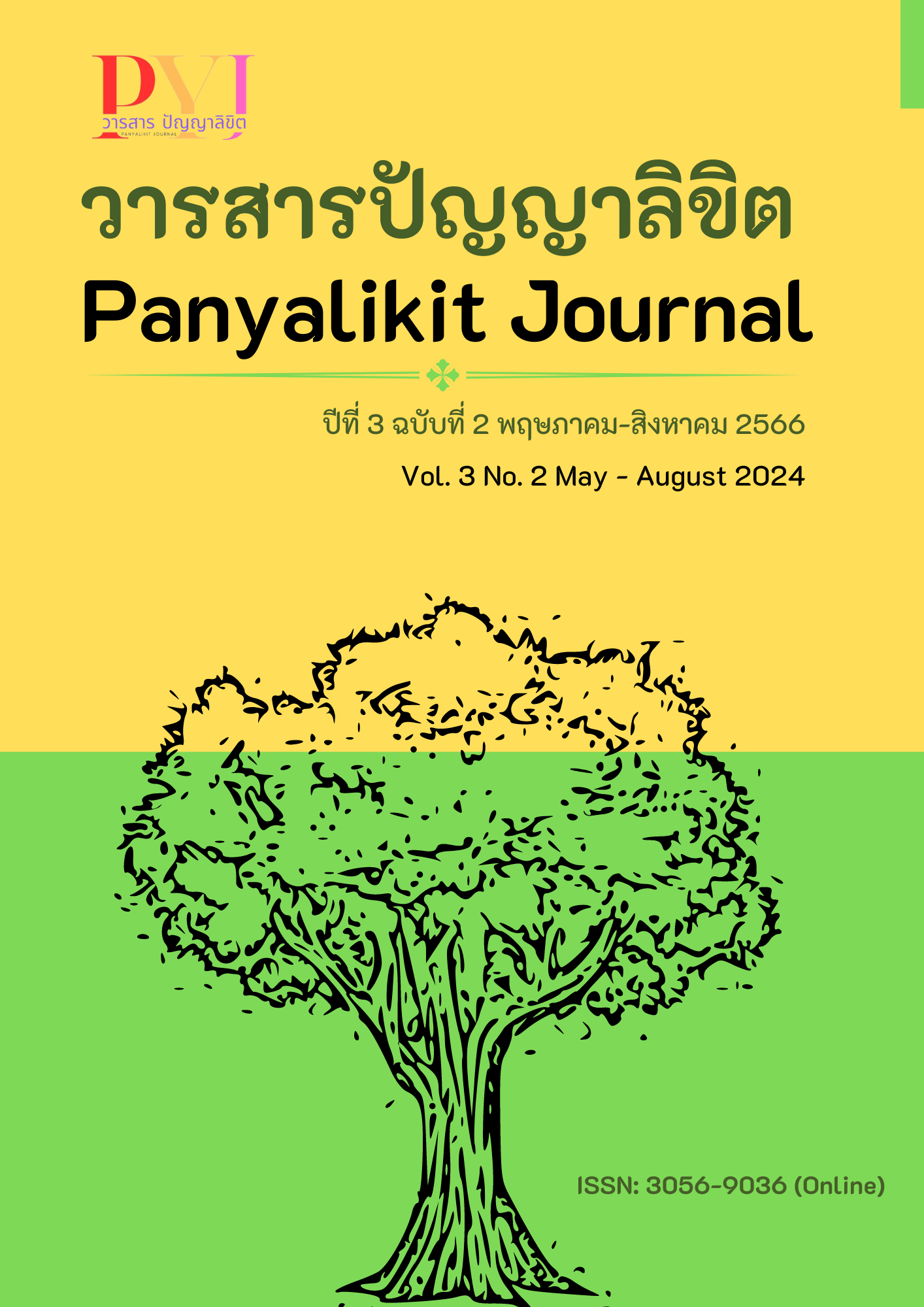A study of the effectiveness of teaching materials on the topic of Sri Chai Singh Dance for the subject of Aesthetic Studies 1 (S21101) at the Mathayom 1 level
Main Article Content
Abstract
Mathayom 1 level. The sample used in the study was Mathayom 1/5 students, semester 1, academic year 2017, Kanchananukroh School. Kanchanaburi Province Secondary Educational Service Area Office 8, a total of 38 people. Tools used include: 1) learning materials on Sri Chai Singh Dance Subject: Aesthetic Studies 1, S21101, Mathayom 1 level 2) Lesson plan including the use of learning materials on Sri Chai Singh Dance Subject: Aesthetic Studies 1 S21101 Mathayom 1 3) Academic Achievement Test created by the student It is a multiple-choice exam with 4 options to choose from, 30 questions, 30 points. 4) Questionnaire on student satisfaction with learning using the study materials on Sri Chai Singh Dance Aesthetic Education Course 1, S21101, Mathayom 1 level. Statistics used in data analysis include percentages, means, and standard deviations. and t-test (t-test dependent).
The results of the study found that
- The efficiency of the teaching materials on Sri Chai Singh dance—subject: Aesthetic Studies 1, S21101, Mathayom 1 level, in field experiments. Efficiency was equal to 88.31/85.89 when used with samples. The efficiency was equal to 92.86/89.30, higher than the set criterion of 80/80.
- Results of comparing learning achievement before and after learning using learning materials on the subject of Sri Chai Singh dance. Subject: Aesthetic Education 1, S21101, Mathayom 1 level. It was found that achievement after studying was higher than before studying using study materials. It is statistically significant at the .05 level.
- Students are satisfied with learning using the learning materials on Sri Chai Singh Dance Subject: Aesthetic Studies 1, S21101, Mathayom 1 level. Overall the average is at a high level.
Article Details

This work is licensed under a Creative Commons Attribution-NonCommercial 4.0 International License.
References
กระทรวงศึกษาธิการ.(2552). ตัวชี้วัดและสาระการเรียนรู้แกนกลางการศึกษาขั้นพื้นฐาน พุทธศักราช 2551 กลุ่มสาระการเรียนรู้ศิลปะ. กรุงเทพฯ: ชุมนุมสหกรณ์การเกษตรแห่งประเทศไทย.
เกริก และจินตนา ท่วมกลาง. (2555). การพัฒนาสื่อ/นวัตกรรมทางการศึกษาเพื่อเลื่อนวิทยฐานะ. กรุงเทพฯ: เยลโล่.
โกสุม สวัสดิ์พูน. (2555). ผลการใช้เอกสารประกอบการเรียนรู้นาฏศิลป์พื้นเมืองสร้างสรรค์ระบำนางรองรำลึก สำหรับนักเรียนชั้นประถมศึกษาปีที่ 6 (วิทยานิพนธ์ครุศาสตร์มหาบัณฑิต). มหาวิทยาลัยราชภัฏบุรีรัมย์.
จเร แดงโสภา. (2553). การพัฒนาเอกสารประกอบการเรียน กลุ่มสาระการเรียนรู้ศิลปะสาระดนตรี เรื่อง ขิม ชั้นมัธยมศึกษาปีที่ 2 (วิทยานิพนธ์ครุศาสตร์มหาบัณฑิต). มหาวิทยาลัยราชภัฏธนบุรี.
ถวัลย์ มาศจรัส และดนัย อู่ทรัพย์. (2548). นวัตกรรมการศึกษาชุด เอกสารประกอบการเรียนการสอน เรื่อง การปลูกพืชผักปลอดสารพิษ “โครงการเกษตรทฤษฎีใหม่ตามแนวพระราชดำริ”. กรุงเทพฯ: ธารอักษร.
นฤดล ดาวดวง. (2554). เอกสารประกอบการเรียน เรื่อง องค์ประกอบของดนตรี สำหรับนักเรียนโครงการจัดการศึกษานอกระบบ โรงเรียนป่าพะยอมพิทยาคม จังหวัดพัทลุง (วิทยานิพนธ์ครุศาสตร์มหาบัณฑิต). มหาวิทยาลัยราชภัฏบ้านสมเด็จเจ้าพระยา.
ปฏิมา ชนินทร์เศรษฐ์. (2557). การพัฒนาเอกสารประกอบการเรียน กลุ่มสาระการเรียนรู้ศิลปะ สาระนาฏศิลป์ เรื่องการแสดงระบำมาตรฐาน ชุด ระบำดาวดึงส์ สำหรับนักเรียนชั้นมัธยมศึกษาปีที่ 2 โรงเรียนวัดหนองเป็ด. ตรัง : โรงเรียนวัดหนองเป็ด.
พัชรียา ทองนพเก้า. (2553). การพัฒนาชุดระบบนาฏลีลาบูชาพรหม กลุ่มสาระการเรียนรู้ศิลปะสาระนาฏศิลป์ ชั้นมัธยมศึกษาปีที่ 2 (วิทยานิพนธ์ครุศาสตร์มหาบัณฑิต). มหาวิทยาลัยมหาสารคาม.
โรงเรียนกาญจนานุเคราะห์. (2559). รายงานการพัฒนาคุณภาพการศึกษา. กาญจนบุรี: โรงเรียนกาญจนานุเคราะห์.
สุวิทย์ มูลคำ และสุนันทา สุนทรประเสริฐ. (2550). การพัฒนาผลงานทางวิชาการ สู่การเลื่อนวิทยฐานะ. กรุงเทพฯ: อี เค บุคส์.


